Introduction
Easements are legal agreements that grant individuals or entities specific usage rights over another's property. These agreements play a crucial role in land development, conservation, and property rights. From granting access to a property to preserving land for conservation purposes, easements shape how land can be utilized and accessed.
Understanding the various types of easements is essential for anyone involved in land transactions, as they balance private ownership with public entitlements. This article explores the different types of easements, their legal implications, termination methods, and the importance of due diligence in property acquisitions. It also highlights the complexities and challenges associated with easements, emphasizing the need for careful navigation and expert guidance in this complex legal landscape.
What is an Easement?
Easements are not merely a legal formality; they play a critical role in the use and development of land. These agreements provide a non-owner the ability to use a particular piece of land for a specific purpose, such as accessing a property or allowing utilities to pass through. Notably, conservation easements are a unique type of agreement where a landowner voluntarily limits certain types of development to preserve the land's natural or historical aspects. Such easements are customized to the land's conservation values and the owner's preferences, potentially offering tax advantages and financial incentives.
Recent legal developments have highlighted the importance and complexity of easements. For instance, the case of the Quackenbush family in Michigan who wished to establish a conservation burial ground—a green cemetery preserving land in its natural state—became a significant legal battle when they challenged a local ban on new cemeteries. Their fight against the township's decision underscores the intersection of private property rights and public interests.
In another context, decisions involving land use can lead to intense scrutiny and legal consequences, exemplified by the conviction of two men for fraud related to false tax returns concerning conservation easements. This case has brought attention to how these agreements are managed and the potential for abuse within the system.
Moreover, understanding easements extends beyond private agreements. Public rights, such as access to shorelines, are also dictated by easement laws. Sellers are required to inform buyers of any public access rights on a property, reflecting the balance between private ownership and public entitlements.
Easement agreements are foundational to land development and conservation, shaping how land can be utilized and accessed both now and in the future. These legal instruments reflect a complex interplay between individual property rights, community needs, and environmental stewardship.
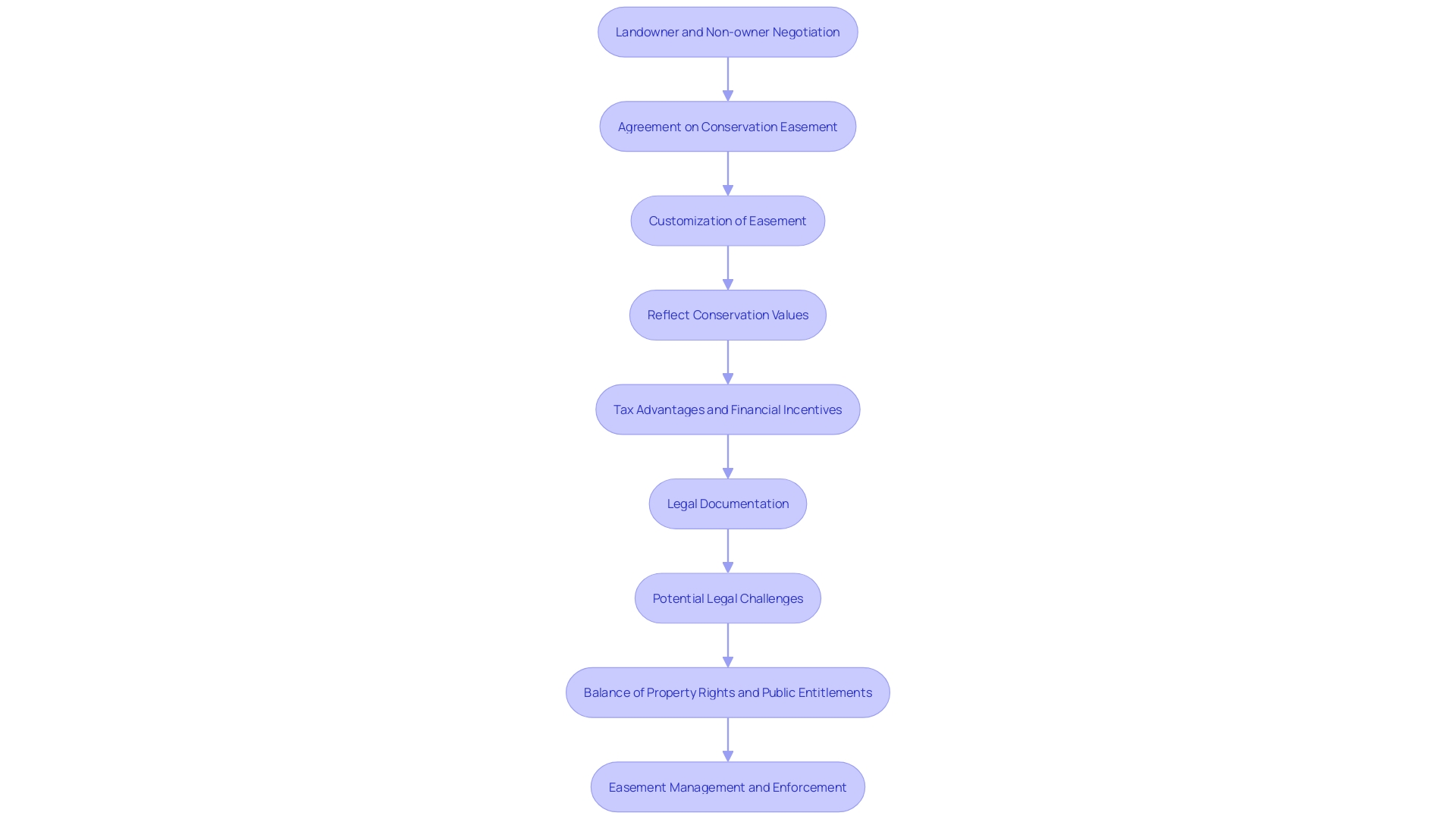
Types of Easements
Easements play a pivotal role in land development, facilitating necessary agreements that can significantly impact the use and value of a property. A development agreement, for example, is a formal contract between a developer and local government outlining the conditions and regulations for a project, often integrating public amenities or benefits into the scheme. Through these agreements, developers navigate the complexities of real estate markets, where variables like fluctuating interest rates and regulatory shifts present challenges. The strategic use of a development agreement can ensure project stability and long-term success.
Conservation easements serve as another key type of agreement, where landowners voluntarily limit the use of their land to safeguard natural, scenic, or cultural attributes. These legal accords, struck with land trusts or government entities, can yield tax advantages and financial incentives, promoting the preservation of vast tracts of land for posterity. Each conservation easement is uniquely crafted to reflect the particular conservation values of the property and the desires of the landowner.
Land purchase agreements are equally crucial, providing a clear, legally binding roadmap for land transactions. These documents detail the buyer, the seller, the price, and the timeline for meeting various conditions, thereby protecting the rights of all parties involved. Whether dealing with a house purchase or a land sale, employing a comprehensive agreement is instrumental in setting clear expectations and safeguarding one's interests.
In essence, understanding these common types of easements and agreements is essential for anyone involved in land transactions and development, ensuring that both public and private interests are balanced and protected.
Express Easements
An express easement represents a formal arrangement where an individual or entity is granted specific usage rights over another's property. This is typically established through a clearly defined written document, such as a deed or legally binding contract. The agreement delineates the parameters of use, the easement holder's privileges, and the landowner's obligations. These easements are often set up for distinct purposes. For instance, they might provide a neighbor with a right of way or enable utility companies to place and service their infrastructure.
In a notable legal case, express easements have been central to discussions about land usage rights, as seen when Peter and Annica Quakenbush launched a legal challenge against Brooks Township's prohibition on new cemeteries. They aimed to establish Michigan's first conservation burial ground, a green cemetery designed to keep the land in its natural condition, highlighting the profound implications of express easements on land development and usage.
Moreover, the dismantling of hydroelectric dams on the Klamath River, celebrated by the Yurok Tribe and conservationists, exemplifies the significant impact of land development decisions. Such actions can restore environmental balance and respect cultural values, illustrating the broader societal and ecological considerations that must be factored into express easement agreements.
When navigating today's volatile commercial real estate market, developers and local governments alike recognize the value of development agreements. These contracts, which set forth the terms and conditions for property development, offer a means to counteract market uncertainties and regulatory shifts, striking a balance between public interests and private development goals.
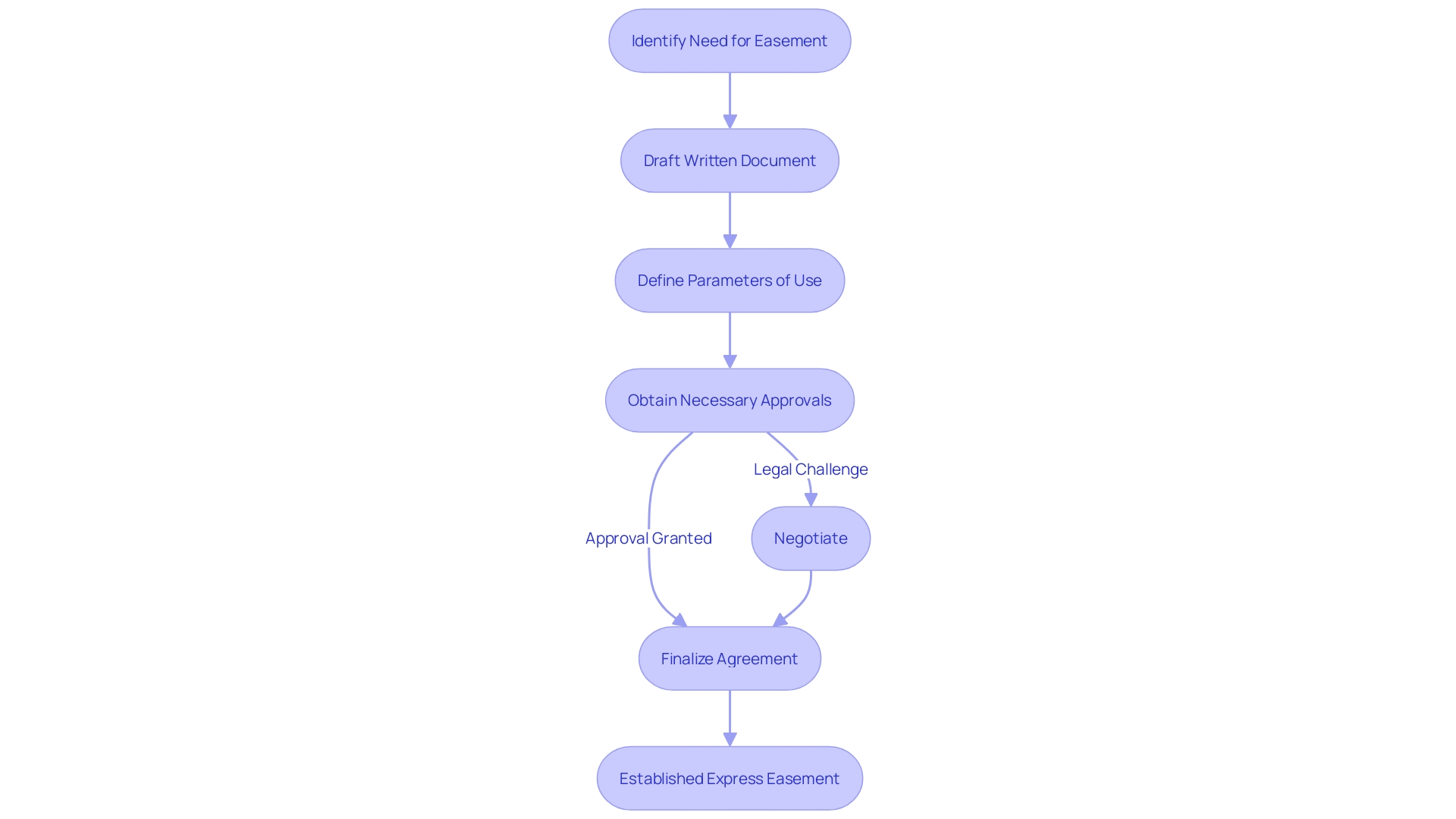
Implied Easements
An implied easement may arise in situations where there isn't a written agreement but the long-established practices or necessities of the parties involved suggest its existence. For instance, if a property has historically been accessed through a neighbor's driveway without dispute, this pattern of use can result in an implied easement, recognizing a right of way that allows continued access.
This concept of property rights extends beyond mere control over a resource to include the right to exclude others from using it. As viewed from the lens of exclusion rather than control, a right of way is not merely about traversing the land but about acknowledging a legally-backed ability to use someone else's property for specific, limited purposes.
Such cases have real-world implications as seen in Brentwood, Missouri, where the George Brothers inherited a property integral to their family's legacy, underscoring the emotional and historical significance that can compound the technicalities of land rights.
Moreover, legal conflicts can arise when a property's use changes or when there's a dispute over access, such as the one in Brooks Township, Michigan, where property rights clashed with municipal regulations, leading to legal action to assert the rightful use of the land.
The concept of an easement also ties into broader land issues, such as those faced by the First Nation, where historical sale and access rights to beach properties have led to protracted legal disputes. Such cases underscore the complexity and importance of clearly defined and honored land agreements.
Land trusts and conservation easements further complicate the landscape of land rights. These are arrangements where landowners voluntarily limit the use of their property to preserve its natural state, which not only protects the land but can also provide financial benefits and tax incentives to the landowner. As the legal landscape evolves, so too does the approach to managing these agreements, as evidenced by high-profile legal cases that scrutinize and potentially reshape conservation easement practices.
In all, the intricate web of rights, historical usage, and legal interpretations surrounding implied easements and land use agreements highlights the need for careful consideration and expert navigation to protect the interests of all parties involved.
Appurtenant Easements
Appurtenant easements are crucial for property owners as they provide rights that are intrinsic to the land itself. These rights are not just for present owners but are also passed on to any subsequent owners when the property changes hands. A classic use of appurtenant easements is to allow the use of a shared driveway, granting passage over one property for the benefit of a neighboring parcel.
The significance of these easements becomes clearer when considering cases like that of Thomas Lee Causby, who owned a farm near an airport and faced severe disruptions due to noise from military flight operations, leading to legal action. Similarly, avigation easements are established to protect airspace over properties in proximity to airports. Such easements are agreements that, while allowing for flight operations, also acknowledge potential impacts like noise and vibrations, often leading to disputes as seen with the Rocky Mountain Metropolitan Airport, where local development has clashed with increasing air traffic.
These challenges underscore the importance of understanding the scope and impact of easements on property development and use. Moreover, as highlighted by guest blogger Tim Mulvaney, local governments frequently impose conditions on development permits to balance community needs, such as dedicating land for floodwaters. These regulations, while aiming to serve the public good, can sometimes lead to constitutional challenges that question the balance between private property rights and regulatory measures.
Land surveys are a critical tool in this context, providing a detailed examination of land, identifying boundaries, and mapping topographic features, as emphasized by real estate professionals. This precise data is fundamental for establishing legal boundaries and understanding the characteristics of a property, thus preventing disputes and ensuring clarity for all parties involved.
In the ever-evolving landscape of land use and property rights, the interplay between easements, property boundaries, and development regulations remains a complex field marked by legal battles and the need for careful navigation of the associated agreements and restrictions.
Easements in Gross
Easements in gross, which are distinct from appurtenant easements, are not attached to the landowner's property rights but instead are granted to individuals or entities, irrespective of property ownership. This type of easement is particularly crucial for utility companies and government agencies that require access across private land to install and maintain essential infrastructure like power lines or pipelines. For instance, in a historic case where Thomas Lee Causby's chicken farm was adversely affected by noise from military flights, it highlighted the significance of understanding airspace rights above one's property, which can be likened to easements in gross when applied vertically.
In recent developments, such as the case in Freestone County, the government's attempt to acquire land through eminent domain for State Park expansion encountered substantial challenges when the appraisal process resulted in a valuation four times higher than the recent purchase price. Similarly, significant projects like the removal of hydroelectric dams along the Klamath River, which are undertaken to support environmental restoration and cultural preservation, demonstrate the complexities involved in managing land rights and easements for long-term benefits. Furthermore, legislative changes, as proposed in Ontario, aim to streamline infrastructure projects by preventing underground infrastructure owners from imposing fees for locating utilities, thus impacting easement negotiations and costs.
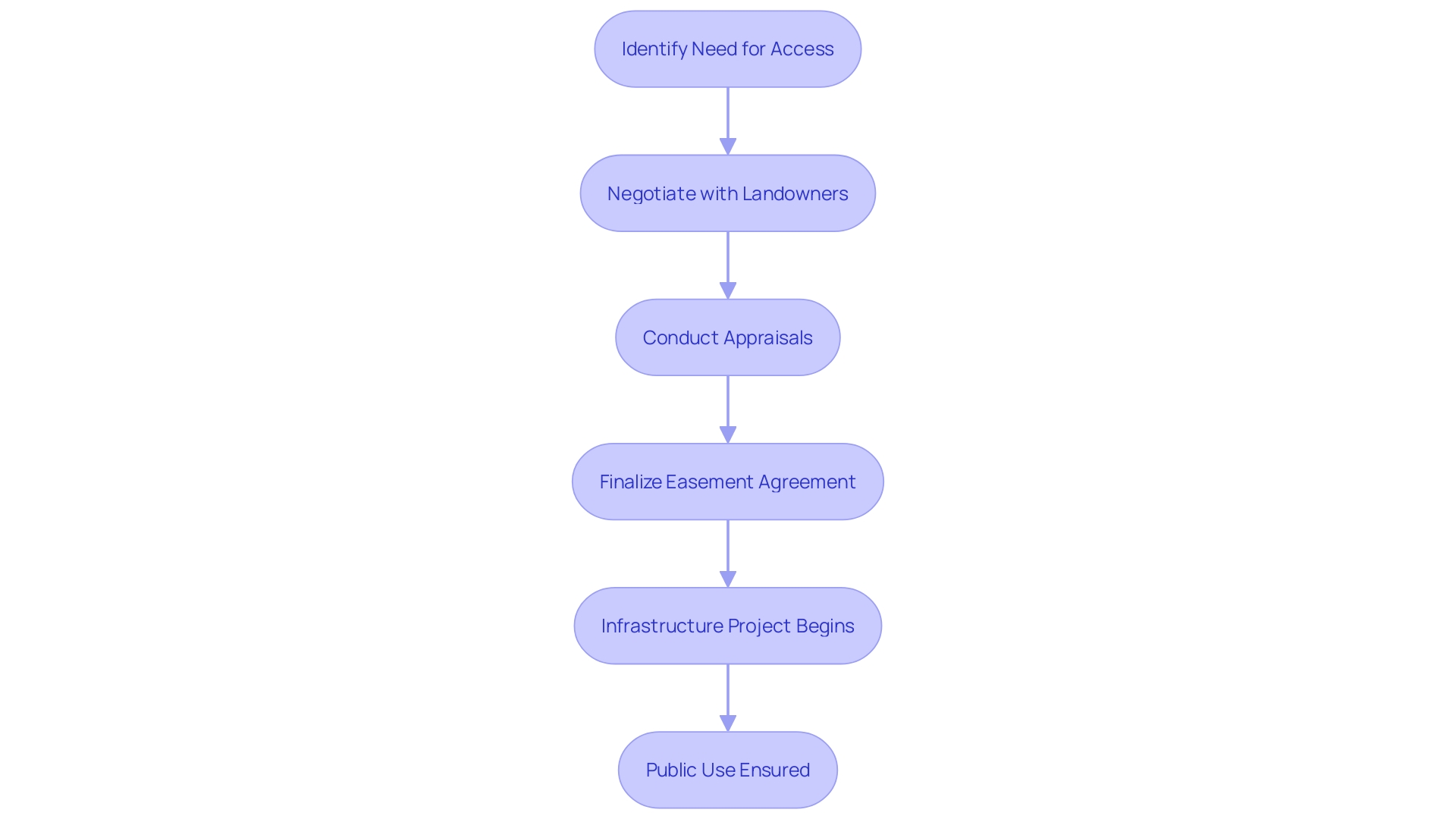
Common Examples of Easements
Land easements play a crucial role in balancing property usage with preservation and rights. A striking example of an easement-related legal matter is the case of Thomas Lee Causby, who owned a chicken farm near a military airport. The aircraft noise was so disruptive it led to the demise of his chickens and the collapse of his business. Causby's lawsuit against the United States hinged on an old common law principle that landowners have rights to the airspace above their property, highlighting the complexities and impacts of airspace easements.
Conservation easements are another key type of easement, designed to protect natural resources while allowing landowners to retain ownership. They restrict certain activities, like construction or subdivision, to preserve the land's natural state. The rise of conservation burial grounds, a form of green cemetery, is a contemporary example of conservation easements in action. These grounds are established through partnerships with conservation organizations and include a plan for perpetual land protection. They cater to the growing interest in green burials, a practice that foregoes embalming in favor of a more eco-friendly approach to burial. Statistics reveal that as of 2023, 60% of Americans are interested in green burial options.
Furthermore, recent legal developments have underscored the importance of understanding easements. For instance, a federal jury's conviction of individuals for fraud related to conservation easements demonstrates the legal system's vigilance over such agreements. This conviction could influence future handling of conservation easements, emphasizing their significance in land development and management.
Easements can be complex, involving multiple layers of rights and requiring careful consideration. They are essential tools for directing land use and ensuring the protection of valuable resources, whether it's the airspace above us or the natural grounds that honor our deceased. Understanding the various types of easements is critical for anyone involved in land acquisition or management.
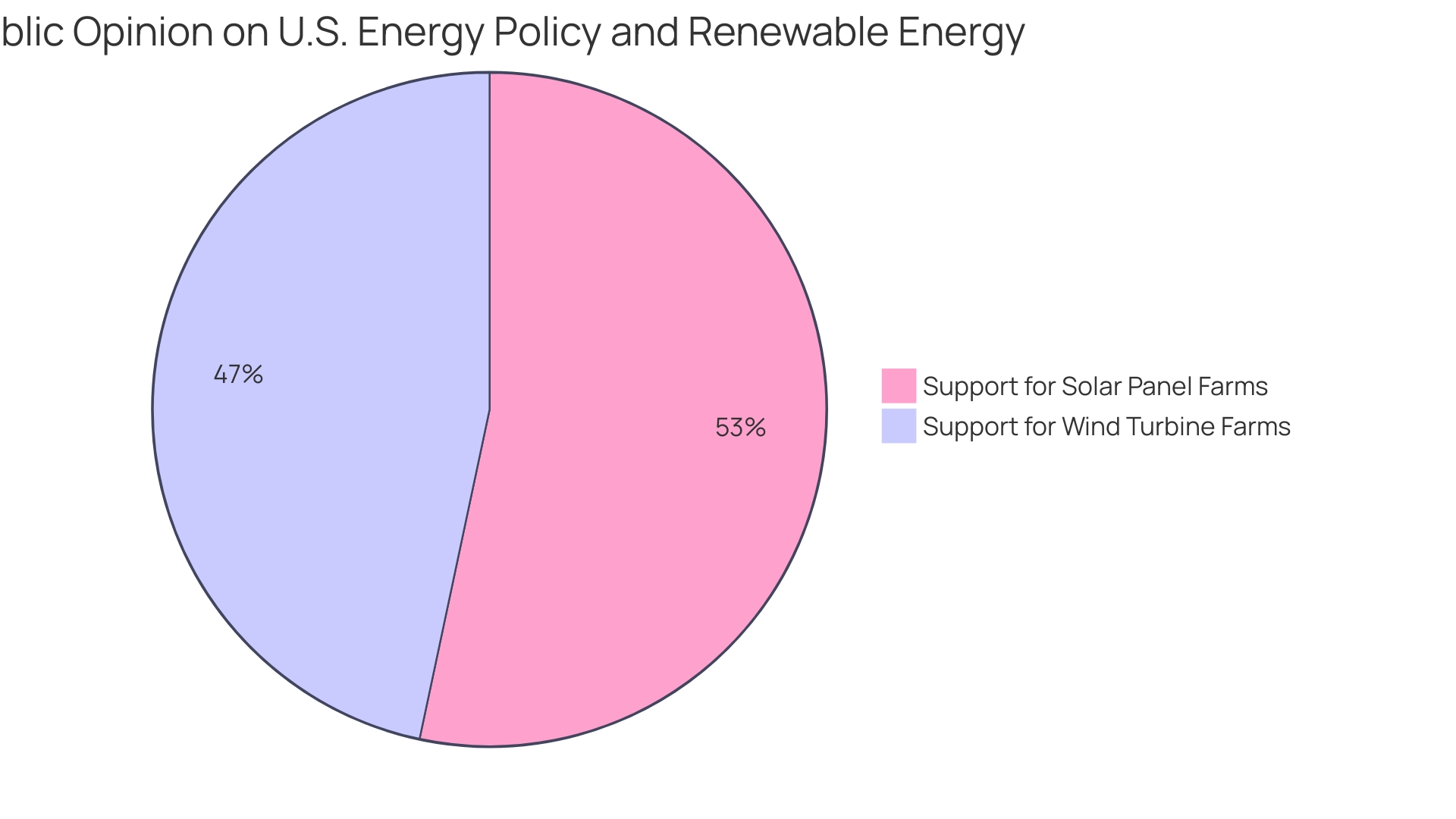
Utility Easements
Utility easements are critical for ensuring that essential services like electricity, natural gas, and water are reliably delivered to communities and properties. These legal agreements provide utility companies with the right to use a portion of land for installing and maintaining their infrastructure. The significance of such easements can be seen in large-scale projects, like a recent initiative which involved a partnership between the federal government and the Yurok Tribe, leading to the removal of hydroelectric dams on the Klamath River in Northern California. This action, aimed at restoring salmon habitats, underscores the complex interplay between infrastructure development and environmental stewardship. Utility companies must navigate various challenges, including economic trade-offs, such as the potential increase in electricity rates due to safety standards, and reputational risks, particularly in areas like California where utilities are under intense public scrutiny. The Federal Energy Regulatory Commission (FERC) offers resources for landowners who may be affected by utility projects, highlighting the importance of public rights and the regulatory process in the development and maintenance of utility infrastructure. In the realm of utilities, development agreements and the balancing of public and private benefits are crucial, showcasing the delicate balance between facilitating essential services and protecting the interests of all stakeholders involved.
Right-of-Way Easements
Right-of-way easements play a critical role in the development and accessibility of land, allowing for the passage of roads, sidewalks, or trails that are essential for the connectivity and functionality of neighboring properties and public services. This type of easement grants a designated party the legal right to traverse another's land for a specific purpose, such as utility companies extending their infrastructure networks. A clear example is the case of Veolia, which operates under tariff rules approved by the Idaho PUC, determining how water lines are extended and who bears the cost, ultimately ensuring that the development doesn't impose unfair financial burdens on existing customers.
Similarly, in Santa Barbara, the adoption of the 'vehicle miles traveled' model as part of environmental reviews for new developments underlines the integral relationship between land use and transportation planning. It's an approach that shifts focus from merely expanding roads to considering the broader implications of development on traffic patterns and the environment, as mandated by California's Senate Bill 743.
The concept of 'public use' has evolved to encompass 'public purpose' and 'public benefit,' as seen in eminent domain cases where the government acquires private land for projects like highway expansions. While intended to serve the public interest, such projects often stir debate over their actual benefits versus the harm they may cause, as evidenced by the expansion of I-405, where despite claims of improving driving experiences, evidence suggests that highway expansion doesn't effectively reduce congestion.
Moreover, the financial sustainability of such projects is brought into question, with some experts pointing out that local governments often lack the necessary funds to maintain the infrastructure they build, leading to a cycle of expansion without adequate investment in upkeep.
In conclusion, right-of-way easements are a complex but vital component of land development, requiring careful consideration of their long-term impact on communities and the environment. The examples highlighted demonstrate the nuanced challenges and decisions faced by those involved in land acquisition and development, emphasizing the need for sustainable and community-focused planning.
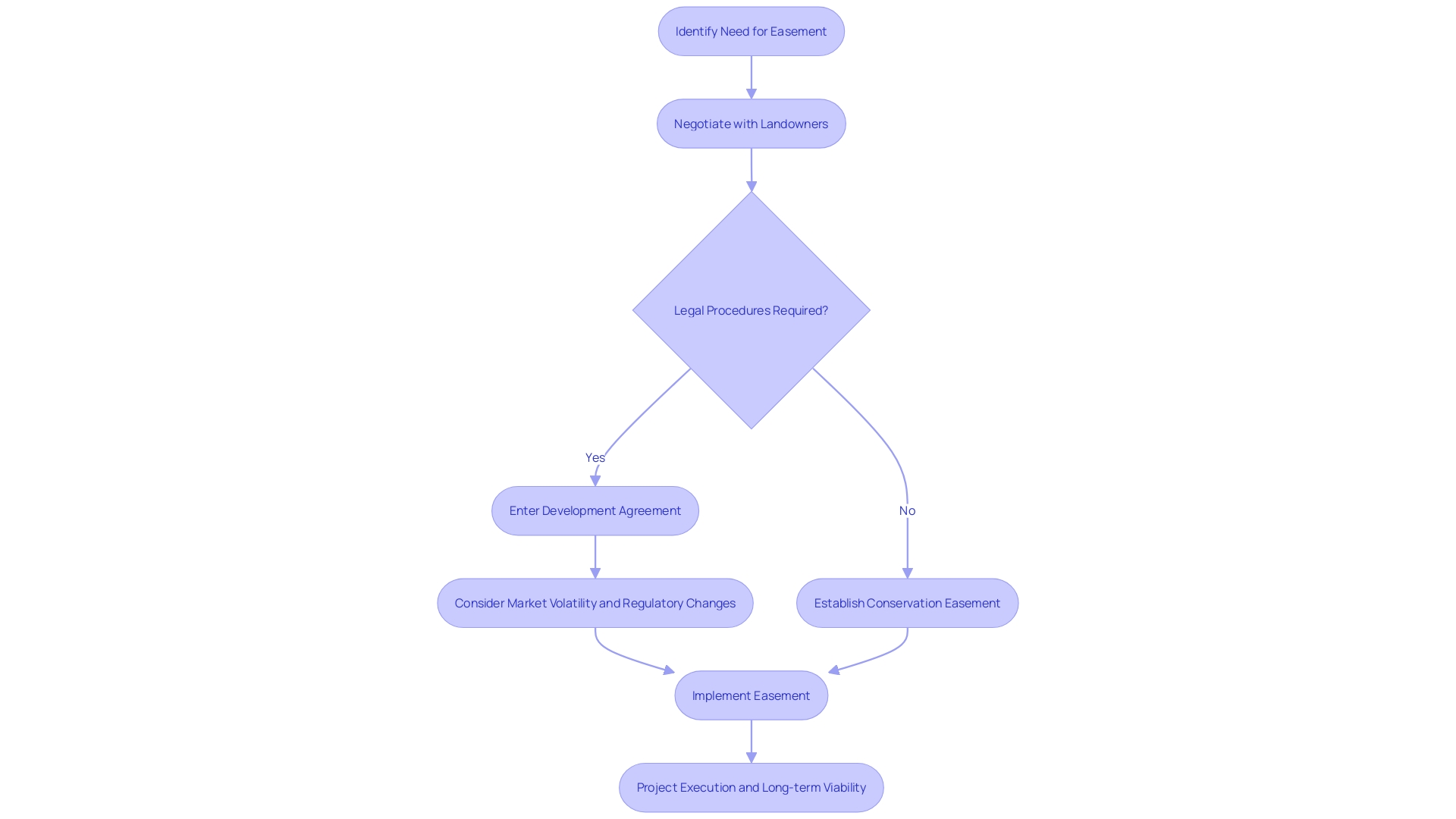
Conservation Easements
Conservation easements serve as a vital tool for maintaining the environmental and cultural significance of a landscape. These legal agreements are negotiated between landowners and either land trusts or government entities to limit the use of the land, preserving its natural beauty and ecological importance. Notably, the landowner retains ownership while agreeing to permanent restrictions that could include prohibitions on construction, land subdivision, or certain agricultural practices. This voluntary act of conservation not only ensures the protection of scenic vistas, wildlife habitats, and historical sites for future generations but can also provide the landowner with financial benefits such as tax incentives.
For instance, the Greater Yellowstone Coalition's acquisition of over 1,500 acres in Montana prevented the establishment of a gold mine, thereby safeguarding the migratory paths of grizzly bears and other wildlife. This action underscores the broader commitment seen across North America, where millions of acres have been conserved through easements, echoing sentiments from government officials and environmentalists who advocate for cooperative efforts to preserve our natural spaces.
Recent legal proceedings, such as the conviction of two men for conservation easement-related fraud, highlight the importance of integrity and scrutiny in the management of these agreements. It's clear that conservation easements are more than just a means to protect land; they reflect a complex layering of property rights aimed at balancing private ownership with the public interest in conservation. This approach has been pivotal in safeguarding ecological treasures like the Appalachian Mountains, which play a critical role as a wildlife corridor and maintain some of the world's most intact temperate hardwood forests. As our climate changes, these conservation strategies become even more crucial for the resilience of nature and the diverse species it supports.
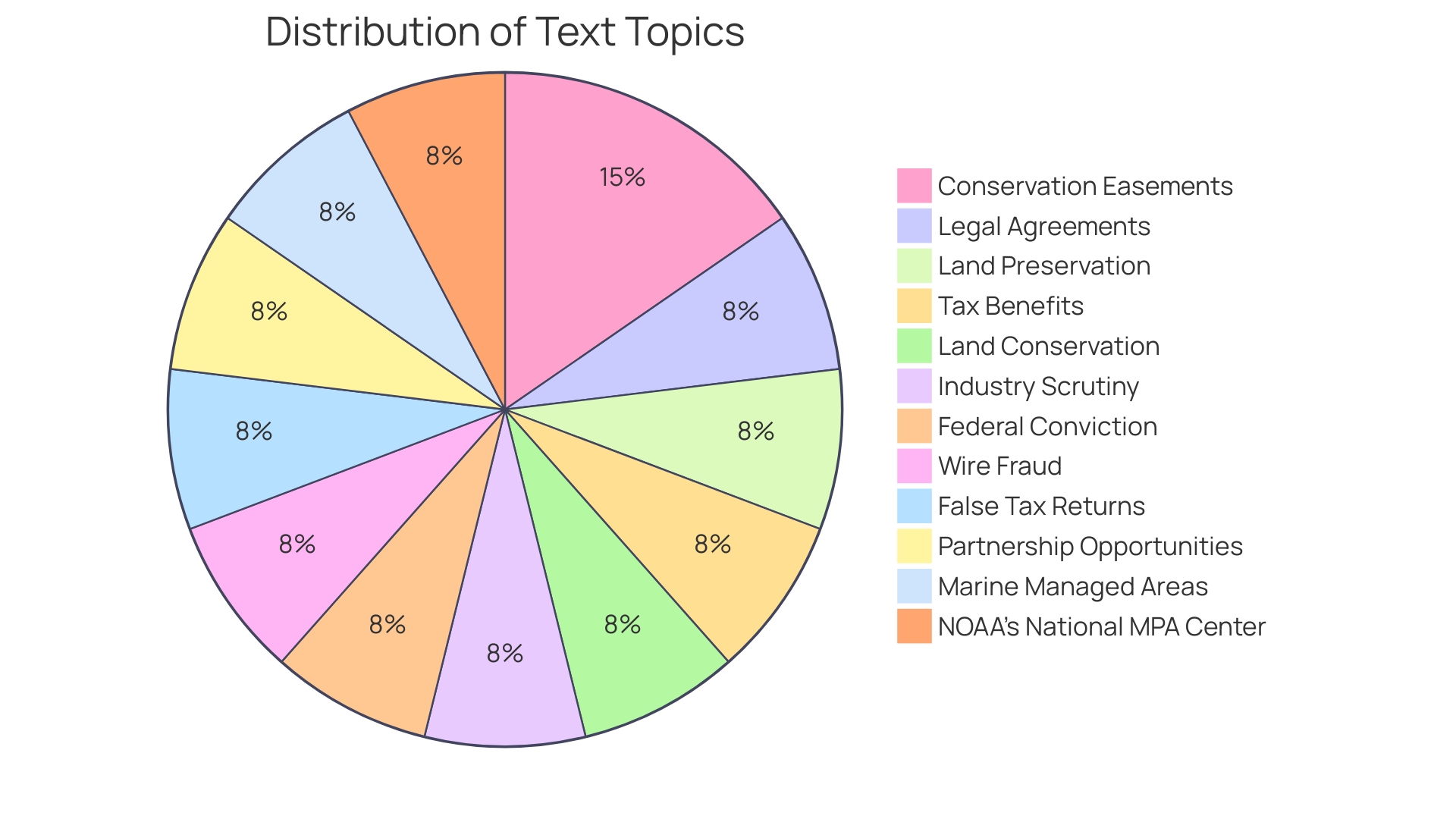
Easements by Necessity
Easements by necessity come into play when a property has no alternative access except through the land of another. These legal pathways are often critical for landlocked properties to reach public roads or connect to utilities. For example, conservation burial grounds, a growing trend in eco-friendly instruments, rely on such easements to ensure perpetual access and preservation. These green cemeteries partner with conservation organizations and utilize conservation easements or deed restrictions to maintain the land's natural state. As of 2023, green burial practices, which forgo embalming for earth-friendly burials, have seen a rise in popularity, with 60% of Americans considering it a viable option, reflecting a 4.3% increase since 2021.
Legal cases and news stories highlight the complexities of land access. Disputes over beachfront access in communities like Kettle & Stony Point and coastal erosion challenges in Bluecliffs emphasize the delicate balance between individual property rights and communal access. These situations underscore the significance of easements and how they are governed by law, impacting both landowners and the broader community.
In the legal sphere, a property right is generally viewed not as a right to control, but rather as a right to exclude others from using a resource. This perspective shifts the focus from active management to passive protection, allowing for specific uses like crossing a property, without infringing on the landowner's rights. This nuanced understanding of property rights shapes the implementation of easements by necessity, ensuring access while respecting ownership.
The rise in sea levels and urban development pressures have further increased the relevance of understanding easements. Minimum lot size regulations and the proffer system in Virginia exemplify local efforts to manage land use while accommodating growth. These legal instruments, including easements by necessity, play a crucial role in both protecting property rights and facilitating responsible land development for generations to come.
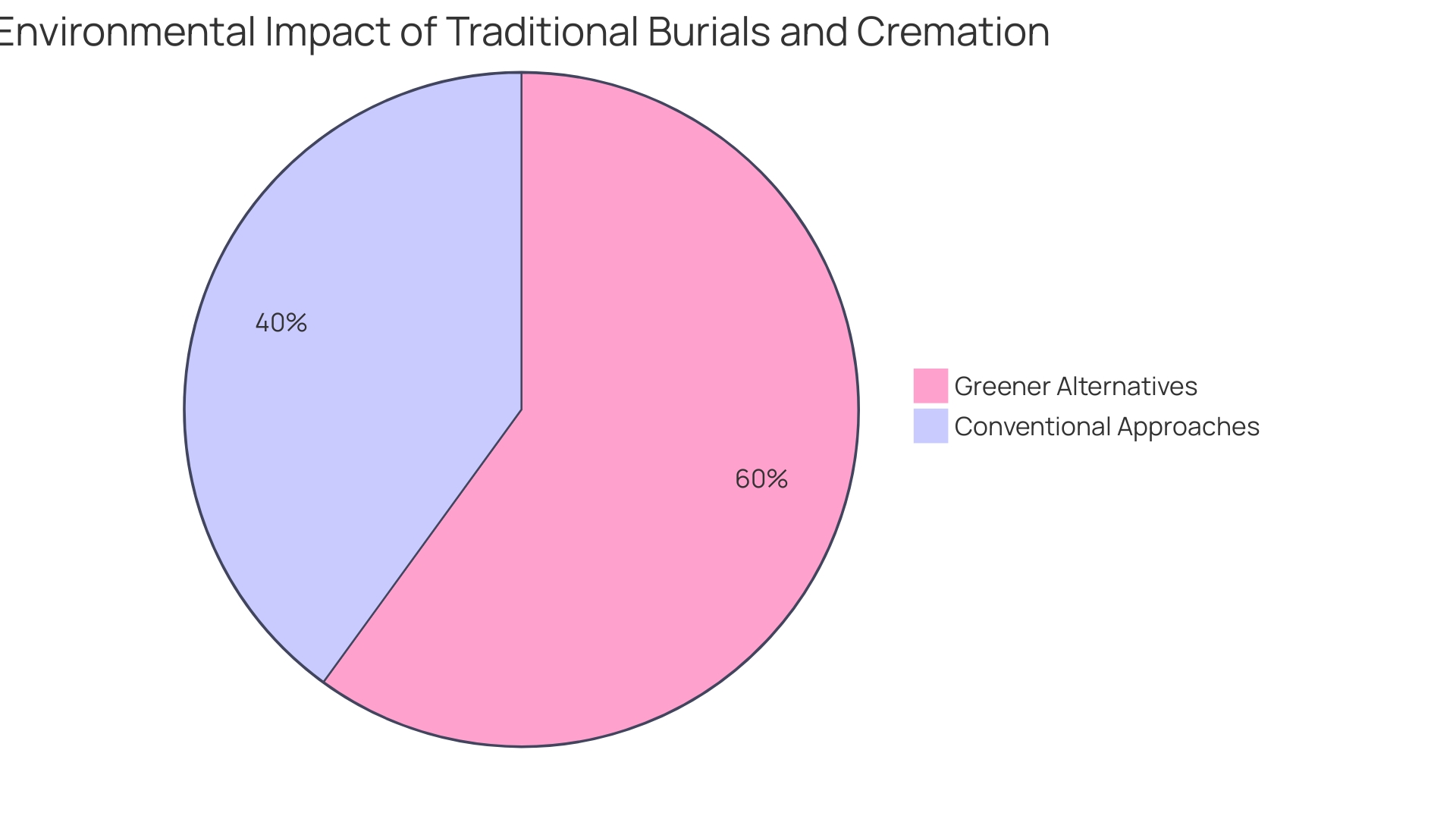
Prescriptive Easements
Prescriptive easements are a form of land use rights that can be acquired by openly using someone else's property without their permission for a certain duration under specific legal conditions. This uninterrupted use must be evident to the property owner and be in a manner that is expected for the type of property involved. As a notable instance, conservation burial grounds offer an example of how land use can be intertwined with cultural practices. These grounds are typically established in partnership with conservation organizations and include plans to protect the land in its natural state through conservation easements or deed restrictions. The resurgence of green burial, a method that eschews embalming for direct earth interment with organic materials, highlights the evolving preferences towards land use and conservation. In 2023, the interest in green burial increased to 60% among Americans, emphasizing the growing trend towards environmentally responsible land use practices.
The legal implications of prescriptive easements can be significant and are rooted in the idea that landowners who do not exercise control over their property for an extended period effectively allow the establishment of new rights. These rights are similar in nature to those created by conservation easements, which are legally binding agreements that restrict land development to preserve its natural qualities. Such agreements demonstrate the multifaceted nature of land rights and the importance of understanding the legal foundations that govern them. Recent legal cases further underscore the complexities of land rights and the potential conflicts that can arise. For instance, a federal jury's conviction of two individuals for conspiracy related to fraudulent conservation easements reflects the ongoing scrutiny and impact of such legal instruments on land use and development. The evolving landscape of land law, highlighted by such cases, emphasizes the need for meticulous legal strategies and awareness of regulatory requirements for land acquisition and use.
Impact on Property Rights
Easements play a pivotal role in land development and management, often shaping the very essence of property utilization. By definition, an easement is a legal provision that allows an individual or entity certain usage rights over another's property. This can lead to nuanced dynamics between the property owner and the easement holder, as the rights granted through the easement can restrict the owner's complete freedom over their land. For example, a conservation easement is a voluntary agreement between a landowner and a conservation organization or government entity, designed to preserve the land's natural, scenic, or historical aspects. Such easements have protected countless acres, ensuring the conservation of vital resources and landscapes for future generations.
In the case of Brentwood, Missouri, where the George Brothers inherited a family-built property, the sentimental and historical value of the land is irreplaceable, highlighting the personal implications of legal land agreements. Similarly, the historic Bruce's Beach in California, once a haven for Black Americans during a time of discriminatory beach access, demonstrates the lasting impact of land use regulations and government actions, such as eminent domain.
The complexities of land rights and easements can also intersect with business aspirations, as seen with the Quakenbushes' endeavor in Brooks Township, Michigan, to establish a conservation burial ground. Their legal battle emphasizes the importance of understanding local land use laws and the potential barriers to implementing innovative land management solutions.
Furthermore, recent legal developments underscore the significance of compliance and the ramifications of misusing easements. The conviction of Jack Fisher and James Sinnott for fraudulent activities related to conservation easements serves as a cautionary tale for those involved in land development and conservation agreements.
As property rights are a cornerstone of our legal system, it is essential for landowners to be well-informed about the various types of easements that may encumber their property, as well as the potential benefits and limitations these legal tools entail. Staying abreast of relevant news, such as landmark court cases, and understanding the complex interplay of rights and restrictions, is crucial for anyone involved in land acquisition and development.
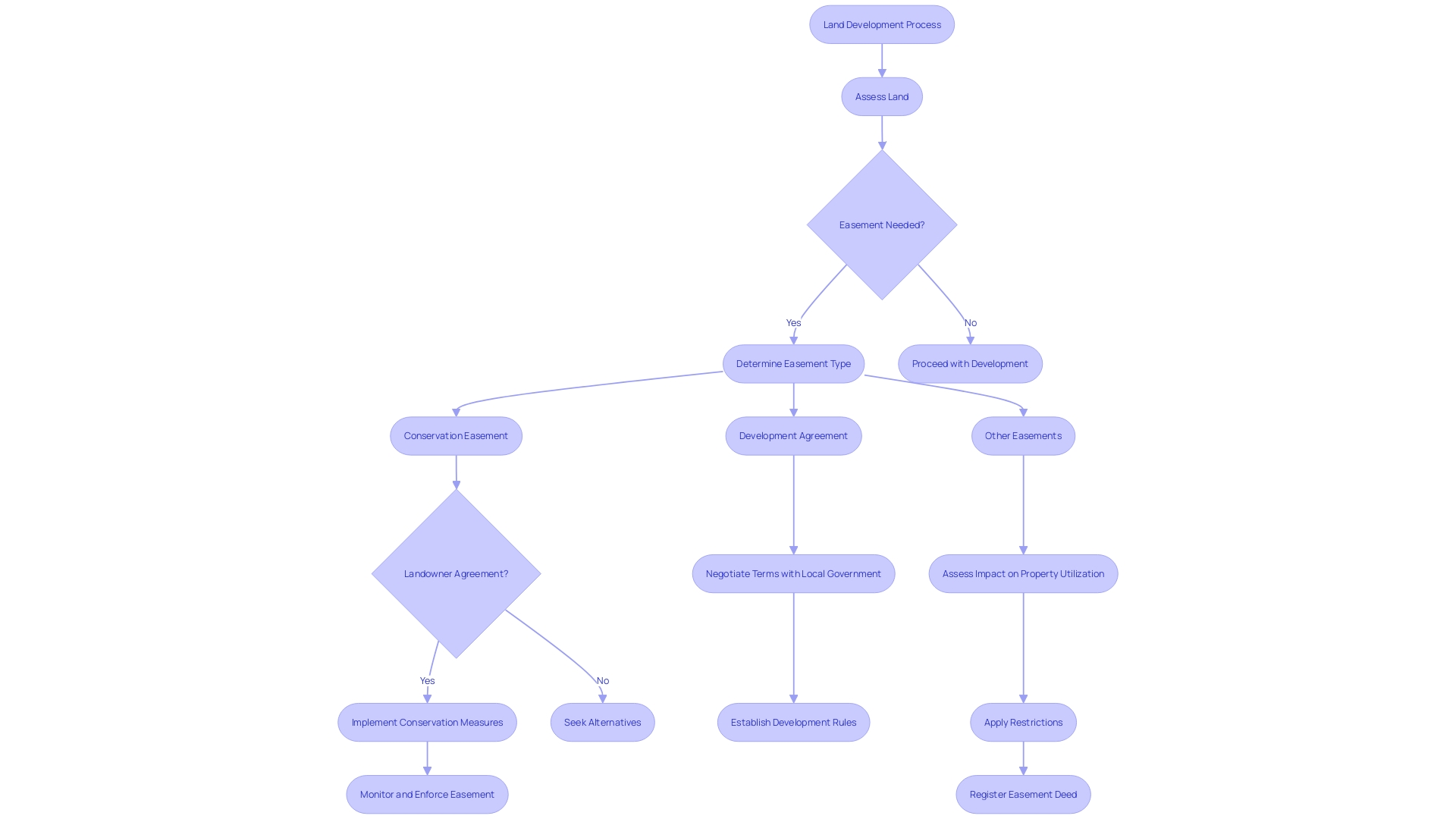
Restrictions and Limitations
Easements are crucial tools for land management and development, but they come with predefined conditions to which both the property owner and the holder of the easement must comply. For example, a conservation easement may be established to create a conservation burial ground, preserving the land in its natural state. This is in line with the growing trend of green burial, a practice that involves interring bodies without embalming and using organic materials, which has seen a significant uptick in interest in recent years.
The rules within easements can restrict the activities permitted on the land, assign maintenance duties, and prevent alterations that could obstruct the easement’s purpose. A notable case is the establishment of conservation burial grounds, where land is protected through a conservation easement, ensuring the land remains undisturbed and natural, aligning with the desires of the 60% of Americans interested in green burial.
Furthermore, development agreements serve as contracts that define the terms of property development, including the inclusion of public benefits. Such agreements are essential for developers looking to navigate the volatility of the commercial real estate market, where political and regulatory changes can pose significant risks to project viability.
A poignant reminder of the importance of adhering to the legal intricacies of property rights comes from the case of a North Carolina homeowner whose home deed was falsely claimed by another, illustrating the limitations of legal recourse once a deed is recorded. This underscores the vital role of understanding and respecting easements and property rights agreements, which are foundational to maintaining control over land use and preventing unwarranted claims.
Maintenance Responsibilities
Easement holders bear the responsibility for the upkeep of their easements, which entails ensuring the area is free of obstructions and the infrastructure, if present, is functioning correctly. When forming an easement agreement, it's vital to clearly define who will handle maintenance duties. A notable case exemplifying the complexities surrounding easement agreements involves the Rocky Mountain Metropolitan Airport and the surrounding residents. The airport, having operated since the 1960s and warned against nearby development, has seen a spike in air traffic as nearby residential areas have expanded. The resulting noise and emissions have led to a protracted dispute, with residents forming the Rocky Mountain Metropolitan Airport Community Noise Roundtable in an attempt to mitigate the issue. Despite these efforts, dissatisfaction remained, escalating to legal actions, including a lawsuit filed by homeowners in Superior, Colorado, who claimed damages from increased exposure to leaded fuel and decreased home values due to operations that allegedly breached avigation easement agreements.
In another context, disputes over land use and access rights can persist for decades, as seen in the case of Kettle & Stony Point and beachfront property owners. Though efforts have been made to reconcile these disputes, there remains a fundamental disagreement over who is entitled to beach access.
Similarly, in Colorado, a legal question arose over who should profit from the mineral rights under a road, after advances in drilling technology made those rights more valuable. The Colorado Supreme Court was tasked with determining whether the property owners adjacent to the road or the entity that purchased the subsurface rights were entitled to the drilling royalties.
These cases underscore the importance of accurate and clear easement agreements to prevent future conflicts and ensure that all parties are aware of their rights and obligations.
Termination of Easements
Easements, while often permanent fixtures on the property, do not have to last indefinitely. They can be dissolved through various legal mechanisms, reflecting the fluid dynamics of property development and ownership. For instance, the termination of easements might occur when the purpose for the easement is deemed no longer relevant or when the easement holder releases their interest in the easement to the landowner.
In a noteworthy case, the Texas Parks and Wildlife Department confronted the complexities of land acquisition and easement termination when attempting to acquire a 5,000-acre property through eminent domain, only to face a valuation dispute. A local judge's appointment of a panel to set a fair market value resulted in a figure that was four times higher than the price paid by the land's purchaser just months prior. This example underscores the importance of understanding the intricate nature of easements and land valuation in the context of termination.
Moreover, the evolving landscape of real estate can influence the status of easements. Development agreements, for example, play a critical role in shaping the utilization of land. These agreements, which are forged between property developers and local governments, outline the terms of development, including the handling of easements for the mutual benefit of both parties. The strategic use of such agreements can provide certainty and stability in the face of market volatility, as emphasized by seasoned developers who navigate these waters with a keen awareness of when, how, and why to enter into these crucial pacts.
In the realm of conservation, understanding the implications of easement termination becomes particularly significant. Conservation easements are unique in that they separate various rights associated with land ownership, such as development rights from grazing rights. These agreements involve a partnership between land trusts or governments and private landowners to preserve land without transferring ownership. As legal constructs that protect land from certain types of development, the termination of conservation easements could have profound implications for environmental conservation efforts.
Legal experts caution that while the termination of easements is possible, it should be approached with a thorough understanding of the legal landscape, as the intricacies of property law and the specifics of individual easement agreements can greatly impact the outcome. The careful navigation of these legal pathways is essential for developers and landowners alike to ensure their interests are adequately protected and advanced.
Methods for Terminating Easements
Easements are crucial for land development and management, but circumstances can change, leading to their termination. One common pathway for ending an easement is through a mutual agreement. Both the property owner and the easement holder can formalize the cessation of the easement rights with a written document, effectively relinquishing the established rights and responsibilities.
In other cases, an easement can be dissolved through abandonment. This occurs when the easement holder ceases to exercise their rights over an extended period, coupled with clear actions that demonstrate their intention to abandon the easement. The cessation of use must be evident and intentional, indicating that the easement holder no longer wishes to retain their rights.
Additionally, the concept of merger applies when the ownership of both the dominant estate (benefiting from the easement) and the servient estate (burdened by the easement) is unified under one entity or individual. In such instances, the easement ceases to exist automatically since one cannot hold an easement over one's own property.
Real-world implications of easement termination can be seen in diverse situations, such as the removal of hydroelectric dams to restore natural ecosystems and support local communities, like the Klamath River Renewal project. The project exemplifies how changes in land use and environmental priorities can lead to the relinquishment of previously held easement rights for the greater good.
Moreover, the intricacies of easements, including their formation and dissolution, are subject to specific legal considerations. This is exemplified in cases where the nature of property ownership—whether for investment or inventory—can influence the outcome of legal decisions, as seen in tax court deliberations.
For practitioners in land acquisition and real estate, staying informed about the various types of easements, such as perpetual easements often used in cell tower lease buyouts, and the legal frameworks governing them, is imperative. These easements provide significant upfront payments, offering a long-term revenue stream, but also come with their own set of conditions that may eventually lead to termination through mechanisms like mutual agreements, abandonment, or merger.
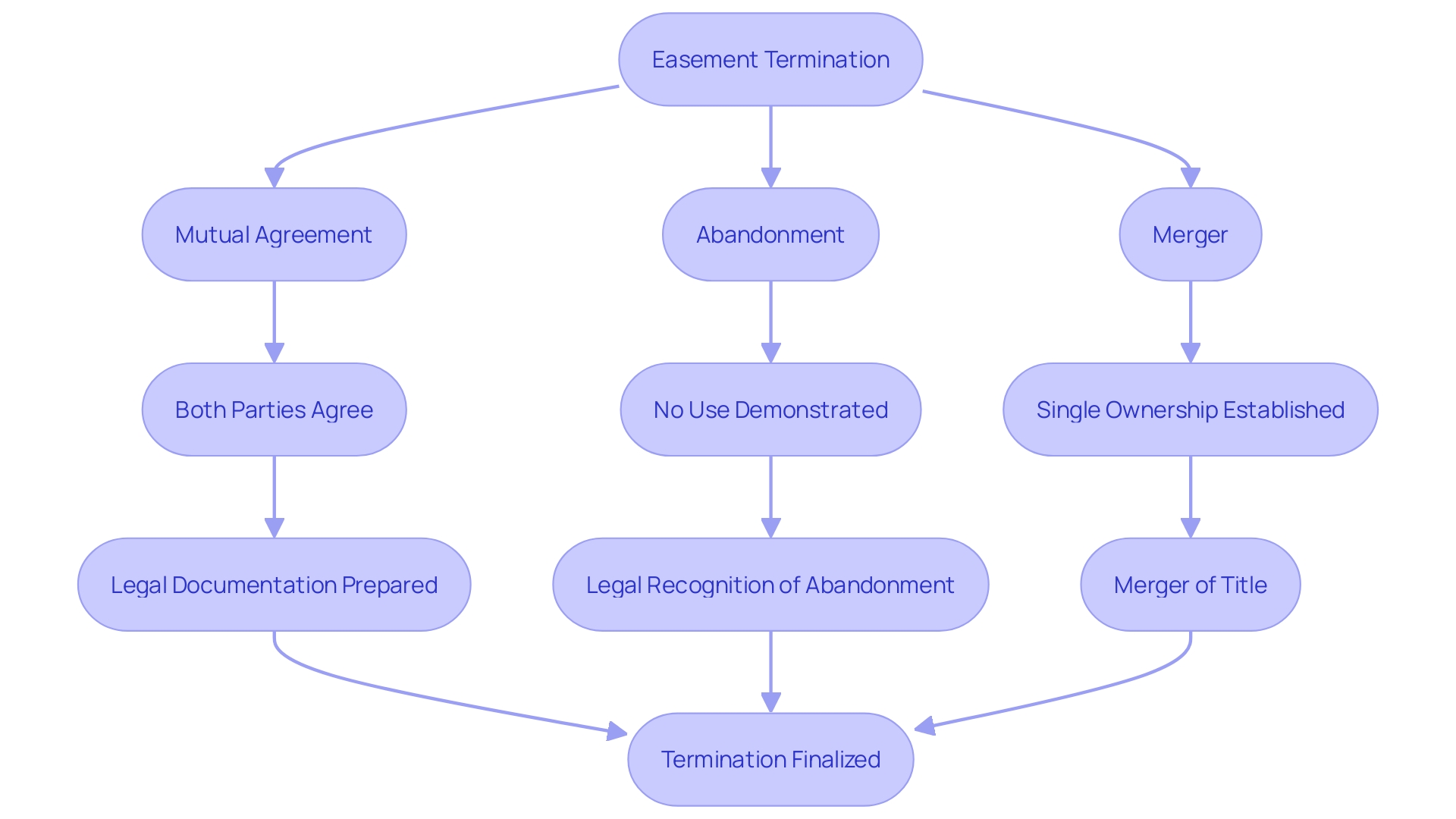
Investigating Easements Before Purchase
When considering a property acquisition, a comprehensive exploration of any existing easements is paramount. This requires a meticulous review of property records, title reports, and survey maps to uncover any recorded easements or potential rights of way that could impact the property's use and value. A poignant illustration of the importance of this due diligence is the historical case of Bruce's Beach in California, where a Black couple's property was seized through eminent domain despite their legal battle to retain it. This underscores the potential consequences of overlooking legal property constraints.
The case of an American client seeking a Japanese countryside property exemplifies the extensive process involved in property due diligence. Akiya & Inaka's consultants sifted through hundreds of properties to pinpoint five that matched the client's specific criteria, emphasizing the level of commitment and attention needed in such investigations.
Moreover, the conviction of Jack Fisher and James Sinnot for fraudulent activities related to conservation easements highlights the legal intricacies and the importance of thorough due diligence in safeguarding against such risks. These easements are intricate legal agreements that limit property development to preserve natural or cultural resources, and as such, they require careful consideration and understanding.
Realtor insights further stress the significance of property surveys, as they define the precise boundaries and characteristics of a property, which is especially crucial during a sale transaction. As the real estate industry emphasizes, accessing the largest repository of property data, such as DataTree, is instrumental in performing legal due diligence and making informed decisions.
In essence, conducting thorough due diligence is transformational for property transactions, ensuring that potential investors and buyers are fully aware of any limitations or legal obligations associated with a property before proceeding with a purchase.
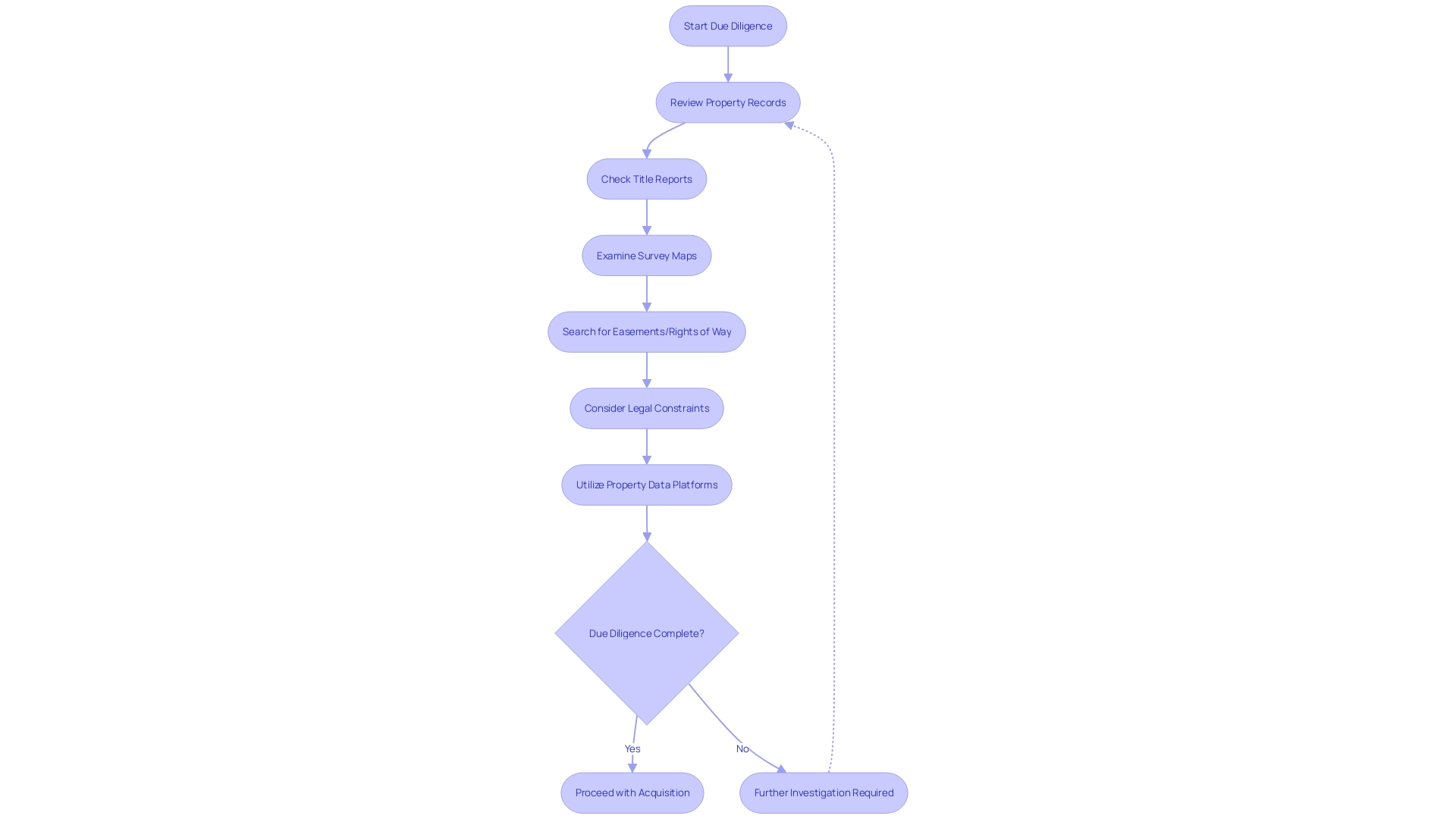
Due Diligence for Buyers and Agents
Understanding the intricacies of property rights is essential for buyers and real estate professionals, especially when it involves easements which can significantly affect ownership. It's important to thoroughly review property documents to grasp the terms and consequences of any existing easements. For instance, a case in Chiba Prefecture illustrated the complexities involved in an Akiya property purchase, where the consultants had to meticulously vet numerous properties against the client's preferences, highlighting the necessity of diligent property analysis.
The real estate landscape is ever-evolving, as seen in Dubai's recent surge in home prices, which climbed by 19 percent in a year, an indication of how market dynamics can influence property values and the implications of ownership rights. Similarly, the rise in property values can affect easements and property rights, which should be a key consideration in the due diligence process.
Legal expertise is invaluable in such matters. The proposed regulations by the US Federal Register, requiring detailed reporting on real estate transactions, underscore the importance of legal compliance and understanding the full scope of property rights, including easements.
The market data points to a significant trend where a substantial proportion of would-be homebuyers, particularly millennials and Zoomers, are unable to fulfill their home purchasing goals due to financial constraints. This context of market desire versus economic reality further stresses the need for clear comprehension of property rights and obligations before entering into any transactions. With a large majority of homebuyers turning to online resources in their search, the real estate industry's digital presence is crucial for providing access to essential property information, including easements and other critical documents that can be efficiently obtained through specialized data reports.
In summary, buyers and real estate agents must prioritize due diligence, harness legal counsel, and stay informed on market trends and regulatory changes to navigate the complexities of easements and ensure the integrity of property transactions.
Client Education and Negotiation
The real estate landscape is continuously evolving, and easements play a crucial role in property negotiations and rights. Real estate professionals are tasked with the responsibility to illuminate the significance of easements, ensuring clients grasp the various types and the impact such agreements have on property rights. It's not just about providing information; it's about doing so compellingly and memorably.
Armed with insights into market standards and an understanding of the financial and cultural context of the parties involved, agents can navigate easement negotiations with skill. For instance, the use of succinct, memorable talking points can simplify complex concepts, facilitating client understanding. Neuroscientists have identified this technique as leveraging neural plasticity, which helps to etch important information into one's memory.
Furthermore, standing firm on one's values and business practices while educating clients on easements is essential. As noted by a CEO of a leading real estate brokerage, the commitment of agents to maintain their ground is a testament to their professional integrity.
Statistics reveal that with 41% of recent buyers initiating their homebuying journey online, and a staggering 97% utilizing the internet in their search in 2020, the importance of digital savviness in real estate cannot be overstated. Therefore, the capacity to effectively communicate the nuances of easements in the digital age is imperative for real estate professionals aiming to guide their clients towards favorable outcomes.
In conclusion, understanding and effectively communicating the implications of easements is a cornerstone of real estate practice, enabling professionals to assist clients in navigating this complex terrain with confidence and expertise.
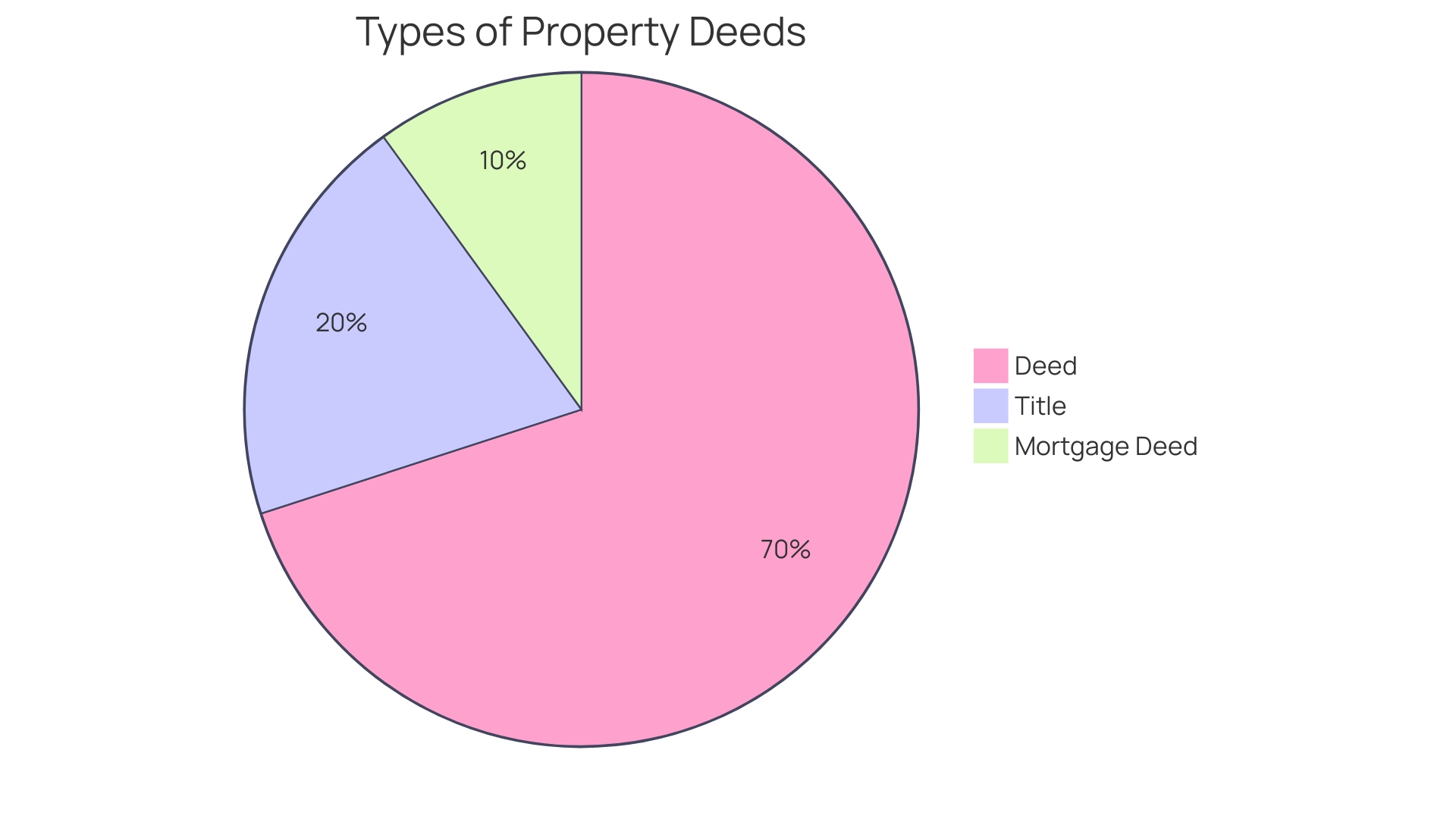
Legal Implications and Consultation
The intricacies of land easements, particularly those related to conservation and green burial practices, are growing in relevance as these practices gain popularity. A conservation easement is a legal agreement that preserves the land's ecological or historical significance by limiting its use and development. As of 2023, the surge in green burial interest—60% of Americans considering it an option, up from 55.7% in 2021—highlights the need for clear understanding of these agreements. With around 420 green burial sites in North America, landowners are increasingly entering into conservation easements, which protect the land in perpetuity while potentially offering tax incentives.
However, legal challenges can arise, as seen in the case where Scenic Nevada challenged a development agreement, with the court affirming their standing based on potential violations of a previous Supreme Court Settlement. Similarly, the conviction of Jack Fisher and James Sinnott for fraudulent activities related to conservation easements underscores the necessity for due diligence in these legal matters.
Contracts and legal agreements, such as easements, form the bedrock of safeguarding property rights and ensuring responsible land stewardship. Legal professionals play a crucial role in navigating these complex arrangements to uphold the rights and obligations of both property owners and easement holders. As the real estate industry evolves, with a historic provider like Savills expanding globally, the importance of expert legal guidance in real estate transactions remains paramount to manage assets effectively and make informed decisions.
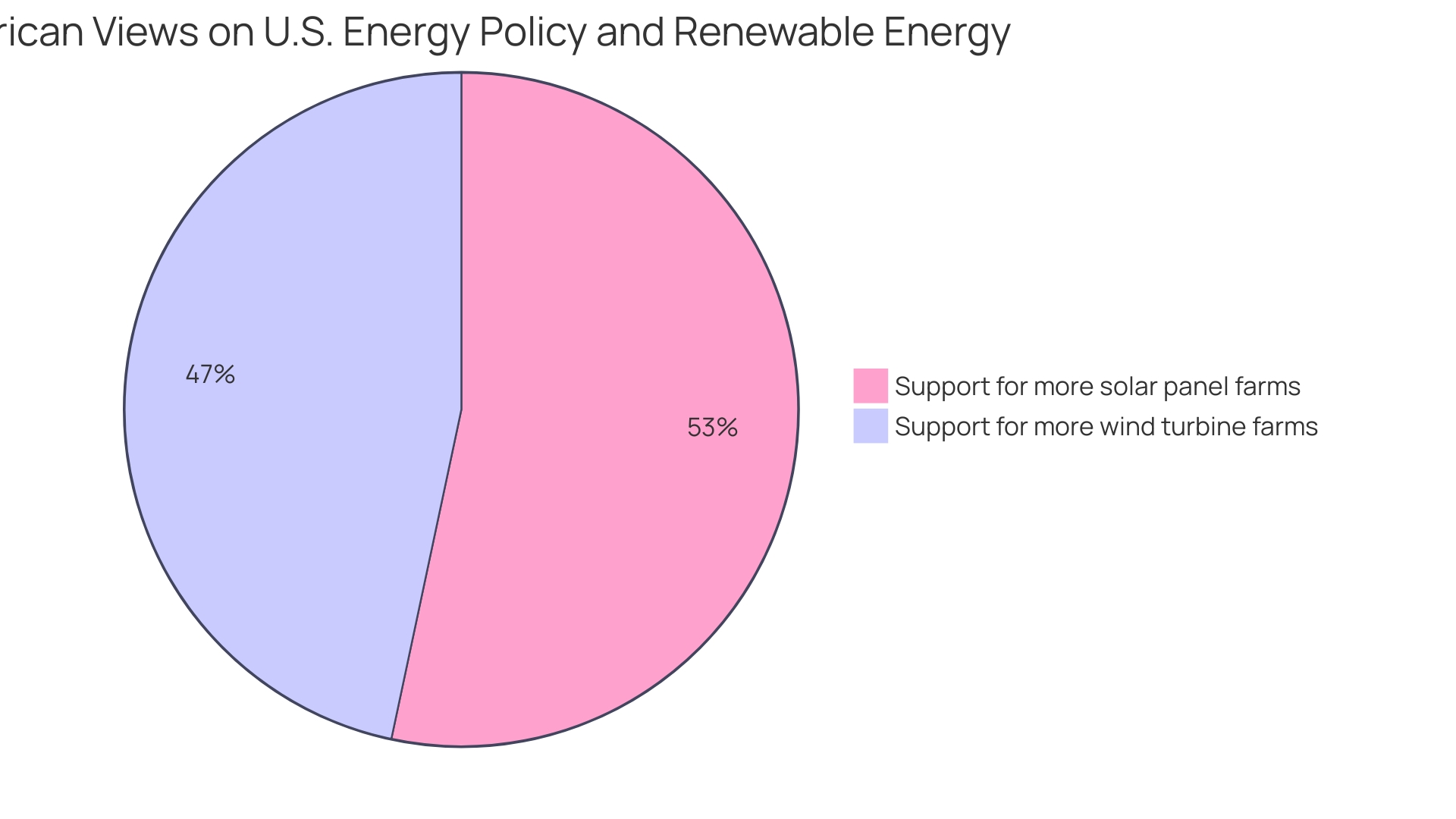
Recording and Documenting Easements
Proper documentation and recording of easements are not merely administrative tasks; they are critical to maintaining the legal integrity of these arrangements. Easements must be meticulously detailed in writing, capturing the intricacies of the rights granted and the obligations imposed upon the involved parties. The written agreement serves as the backbone of the easement, ensuring that both the property owner's and the easement holder's interests are safeguarded. Once crafted, this document should be filed with a government or county recorder's office, which preserves the agreement in public record, providing transparency and notice to all parties involved, including potential future property owners.
This systematic approach to recording easements is mirrored in the procedures followed in high-profile cases. For example, in a notable tax court case, the Donor maintained that a property initially acquired as inventory was later designated as investment property, affecting the character of the property for tax purposes. The court had to evaluate several factors, such as the purpose of acquiring the property and the efforts to sell it, demonstrating the complexity of land transactions and the importance of clear, recorded agreements.
In the current real estate climate, where natural disasters have spurred a 21% increase in insurance premiums, the clarity of property boundaries and rights can have substantial financial implications. A land survey, a critical component of the easement process, establishes exact property lines and features, preventing disputes and misunderstandings. The recent Policygenius Home Insurance Pricing Report highlights the pressure on property owners, with some states like Florida seeing a staggering 35% increase due to events like Hurricane Ian. In this context, the precision and foresight offered by a properly recorded easement can be invaluable in managing risk and maintaining the property's value and integrity.
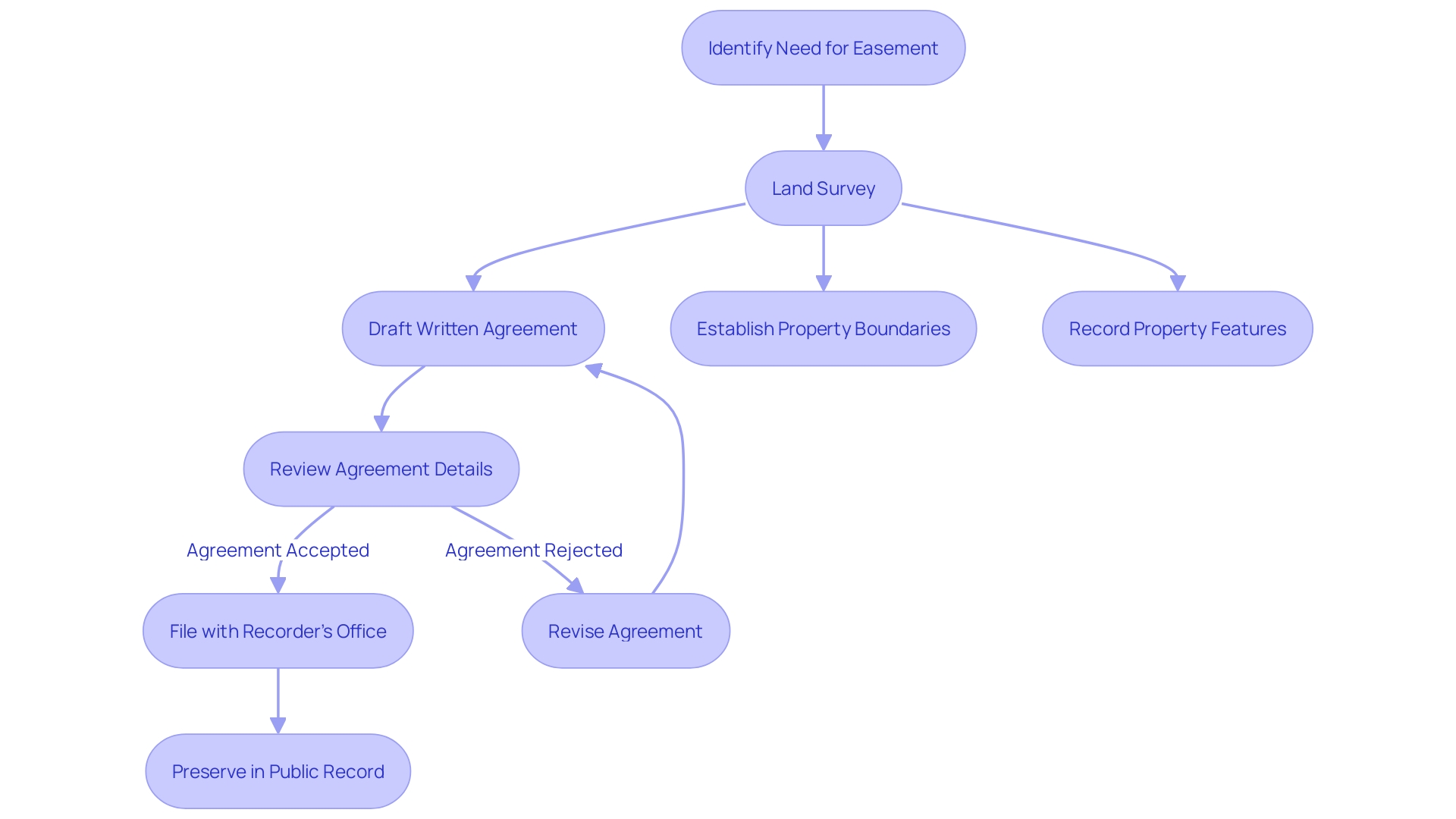
Conclusion
Easements are crucial in land transactions, balancing private ownership with public entitlements. Understanding the various types of easements is essential for navigating land development and conservation.
Different types of easements serve specific purposes. Development agreements ensure project stability, while conservation easements preserve land's natural or historical aspects. Land purchase agreements protect the rights of all parties involved.
Express easements are formal arrangements granted through written documents, while implied easements arise from historical usage. Appurtenant easements provide rights intrinsic to the land, and easements in gross are granted irrespective of property ownership.
Utility and right-of-way easements ensure reliable service delivery and connectivity. Prescriptive easements are acquired through open use of another's property.
Conservation easements are vital for preserving environmental and cultural significance. Easements by necessity allow access to landlocked properties, and termination methods dissolve easements when no longer relevant.
Thorough due diligence, legal expertise, and proper documentation are key in land transactions. Real estate professionals play a crucial role in educating clients and navigating negotiations.
Proper recording and documentation of easements maintain their legal integrity. Land surveys establish boundaries and prevent disputes.
In conclusion, understanding easements is essential in land transactions. Thorough due diligence, legal expertise, and proper documentation are key to navigating the complexities of easements in a balanced and informed manner.




